Drinking coffee is a pastime of millions of people
all over the world. Coffee machines make it possible to
meet the demand of all these people. Without coffee
makers, it would not be possible.
Well, maybe not quite impossible...
 During the years of the opening of the wild
west in the United States, some cowboys made their
coffee by straining
ground coffee in a clean sock and then dousing the socks in
cold water. Then they heated the cold coffee water over
a campfire and drank it from tin cups. During the years of the opening of the wild
west in the United States, some cowboys made their
coffee by straining
ground coffee in a clean sock and then dousing the socks in
cold water. Then they heated the cold coffee water over
a campfire and drank it from tin cups.
|
The first
coffee machine (a percolator) was invented in 1818 by Mr.
Laurens, a Parisian metal smith. The machine was continually modified and new
versions of his coffee machine continued to emerge until
1960.
This is when the first paper filters for coffee
machines were put into use. This simple change created
an unbelievable increase in coffee machine sales.
People
had always wanted the product, but didn’t like the time
it took to clean up and prepare with the cloth filters.
Coffee makers have changed in design as well. The
early ones were just created to do the job; no one
really cared what they looked like.
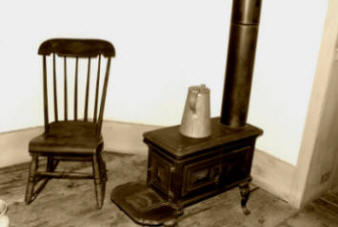
Today’s coffee makers come in all colors and sizes to
accessorize nicely in any kitchen. There are also many
different brands of coffee machines, and each has their
own unique looks to attract consumers.
Percolators and Drip Pots
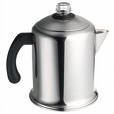 A coffee percolator, or caffettiera, is a type of pot
used to brew coffee. The French developed the "pumping
percolator," in which boiling water in a bottom chamber
forces itself up a tube and then trickles (percolates)
through the ground coffee back into the bottom chamber. A coffee percolator, or caffettiera, is a type of pot
used to brew coffee. The French developed the "pumping
percolator," in which boiling water in a bottom chamber
forces itself up a tube and then trickles (percolates)
through the ground coffee back into the bottom chamber.
Coffee percolators once enjoyed great popularity, but were
supplanted in the early 1970s by automatic drip coffee
makers, and more recently by the French press, as well
as a renewed interest in espresso coffee. Percolators
still have a following, since the coffee has a
distinctive quality that some particularly appreciate.
(click> Others have Real Problems with the Taste)
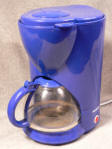 In 1972, the first automatic drip-brew coffeemaker for
home use, Mr. Coffee, was introduced. It combined
aspects of both the drip-brew process and the
percolating process with the added feature of heating up
the water using an electric element in a separate
chamber. Drip coffeemakers are currently the most
popular way of making coffee at home because of their
convenience; however, some people feel that the taste
complexity of coffee is lost when this method is used.
In 1972, the first automatic drip-brew coffeemaker for
home use, Mr. Coffee, was introduced. It combined
aspects of both the drip-brew process and the
percolating process with the added feature of heating up
the water using an electric element in a separate
chamber. Drip coffeemakers are currently the most
popular way of making coffee at home because of their
convenience; however, some people feel that the taste
complexity of coffee is lost when this method is used.
Mr. Coffee has been the leading coffee machine manufacturer in the
United States for centuries. This is because the company
continually changes or adds new products to meet the
needs of the consumer. Bunn coffee makers lead the
industry in commercial drip-brew coffee maker sales.
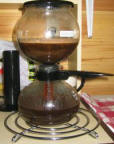 Vacuum brewers operated based
on the vacuum principle. The Napier Vacuum
Machine, invented in 1840, was an early example of this
type. While generally excessively complex for everyday
use, vacuum devices were prized for producing a clear
brew, and were actually quite popular up until the
middle of the twentieth century.
Vacuum brewers operated based
on the vacuum principle. The Napier Vacuum
Machine, invented in 1840, was an early example of this
type. While generally excessively complex for everyday
use, vacuum devices were prized for producing a clear
brew, and were actually quite popular up until the
middle of the twentieth century.
The principle of a
vacuum brewer was to heat water in a lower vessel until
expansion forced the contents through a narrow tube into
an upper vessel containing ground coffee. When the lower
vessel was empty and sufficient brewing time had
elapsed, the heat was removed and the resulting vacuum
would draw the brewed coffee back through a strainer
into the lower chamber, from which it could be decanted.
(I stopped using my Vacuum brewer around 1952; it
really wasn't that easy to use and clean.
Webmaster Comment)
Espresso Makers
An espresso machine is used to produce the traditionally
Italian coffee beverage called espresso. A
professional operator of such a machine is called a
barista. The knowledge required in making the finest
espresso is considered to be a craft, similar to artisan
baking.
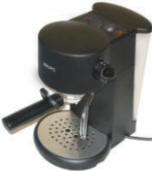
The act of producing a shot of espresso is colloquially
termed pulling a shot, because old lever-style espresso
machines required pulling a long handle to produce a
shot. When the brew process begins, pressurized
water at 200±9°F and approximately 130 PSI, is forced
into a grouphead and through ground coffee in a
portafilter. Water cooler than the ideal zone causes
sourness; hotter than the ideal zone causes bitterness.
High-quality espresso machines control the temperature
of the brew water within a few degrees of the ideal.
This process produces a rich, almost syrupy beverage by
extracting and emulsifying the oils in the ground
coffee.
Varying the fineness of the grind, the amount of pressure used to
tamp the grinds, or the pump pressure itself can be used
to bring the extraction time into this ideal zone. Most
prefer to pull espresso shots directly into a pre-heated
demitasse or shot glass, to maintain the ideal
temperature of the espresso.
An espresso machine also has a steam wand which is used to steam
and froth milk for milk based espresso beverages such as
the cappuccino and latte.
Coffee Press
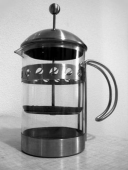 A French press, also known as a press pot, coffee press,
coffee plunger or cafetičre, is a coffee brewing device
popularized by the French. Its operation is simple and
it produces a stronger coffee than other devices.
A French press, also known as a press pot, coffee press,
coffee plunger or cafetičre, is a coffee brewing device
popularized by the French. Its operation is simple and
it produces a stronger coffee than other devices.
A French press consists of a narrow cylindrical jug usually made of
glass or clear plastic, equipped with a lid and a
"plunger" which fits tightly in the cylinder and which
has a fine wire or nylon mesh acting as a filter. Coffee
is brewed by placing the coffee and water together,
leaving to brew for a few minutes, then depressing the
plunger to separate the coffee at the bottom of the jug.
Because the coffee grounds are in direct contact with the
brewing water, coffee brewed with the French press
captures more of the coffee's flavor and essential
oils, which would become trapped in a traditional drip
brew machine's paper filters. French pressed coffee is
usually stronger and thicker and has more sediment than
drip-brewed coffee.
Because the used grounds remain in the drink after brewing,
French pressed coffee should be served immediately so as
to not become bitter from over-extraction. A typical
8-cup French press is considered expired after 20
minutes.
Coffee for use in a French press should be of a consistent, coarse
grind. The use of a burr mill grinder gives a more
consistent grind than the whirling blade variety.
Coffee Machines
available at the Coffee Shop,
and mugs, gifts, grinders, gourmet coffee beans, too.
Follow the advice in this website and you'll have your friends and family
eagerly responding to your next call of
"Anyone for Coffee?"
|
|